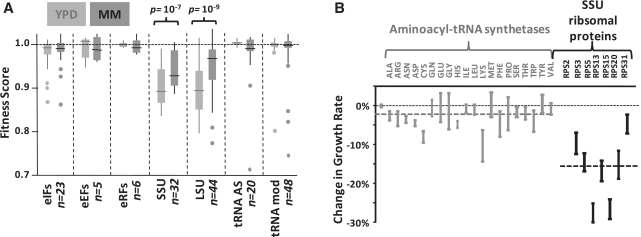Figure 4.
Components of the translational machinery that exert rate limitations on global translation. (A) Sensitivity of yeast fitness to 50% reductions in gene dosage for different translation-related proteins. Data were selected for heterozygous diploids in the case of single genes, and for homozygous deletions in the case of duplicated genes (the average effect of both homozygous deletions was considered in this case). Data are grouped according to translation initiation (eIFs), elongation (eEFs) and termination (eRFs) factors; small (SSU) and large (LSU) ribosomal subunit proteins, aminoacyl-tRNA synthetases (tRNA AS) and tRNA modifying enzymes (tRNA mod). Fitness effects in rich medium (YPD, fast growth) and defined medium (MM, slower growth) are summarized. The box-plots indicate the median (line), 25th/75th percentile range (box), full range without outliers (feathers) and individual outliers (points). (B) Growth rate measurements for the 20 possible heterozygous aminoacyl-tRNA synthetase deletions and for the 7 essential, non-duplicated small ribosomal subunit proteins. These data confirm the competition data in (A). Error bars indicate the standard deviation observed for three independent samples.

